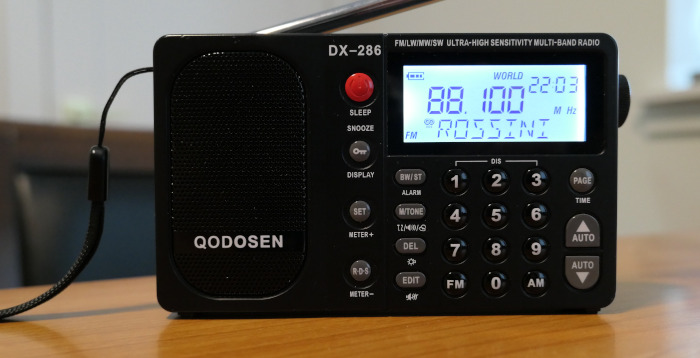
Introduction
Yes, I bought another radio. Even though I hadn't planned to. Even though it uses an 18650 lithium-ion battery, which I have complained about mightily in the past. Even though it's from a new manufacturer.
Yes, but.
In 2023, a new radio appeared on the scene from a new Chinese manufacturer, Qodosen. The SR-286 attracted notice for both good and bad reasons.
The good: instead of using a Silicon Labs chip as many other DSP radios do, it used the NXP TEF6686 chip, commonly used in motor vehicles. There were glowing reports of the radio's sensitivity and selectivity. The FM section of the radio especially had a number of options not found in other radios. It supported direct connection to an external antenna for AM and shortwave use. FM reception offered stereo sound when headphones or earbuds were used.
The bad: the controls were quirky, to say the least, with hard-to-memorize numeric sequences required for some basic functions. There wasn't much of a user's manual to help, either. Even so, some of the other ergonomic aspects of the radio were quite good. In any event, it was hard to get, and cost north of $120. Some defaults made it difficult to use the radio on FM in North America. There were rumors that the TEF6686 chip was in short supply.
In retrospect, it appears that the SR-286 was a prototype - though, interestingly, it was still being sold after its follow-up model went up for sale. In 2024, Qodosen rolled out the DX-286. The internal circuitry was the same as the SR-286. Even so, there were many improvements. The controls were vastly simplified. A comprehensive user's manual was provided (though there are places where it could be clearer). The issue with the spacing of FM channels in North America was fixed. The cost went down to around $80. It could be purchased through Amazon.
A buyer still had to provide their own 18650 button-top battery. Some viewed this as a negative; I viewed it as an opportunity to research batteries to find higher-quality batteries than the ones I had encountered in the past. (See my XHDATA D-808 review for more on that subject.) I made sure to buy a battery not from Amazon, with the correct capacity (3000 mAh appears to be sufficient for the purpose.) After I bought the radio, Qodosen began offering a package that included two batteries along with the radio at additional cost.
DX-286 features
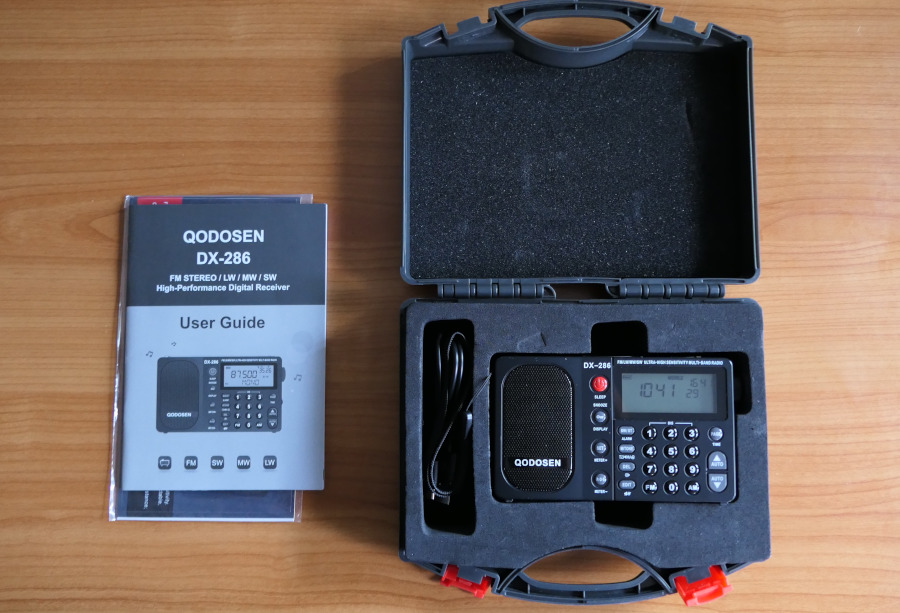
I ordered my DX-286 from Amazon. The package (right) included a hard-shell carrying case with a handle, a USB charger cord, and a comprehensive user's manual. Even though controls have been simplified on this radio compared to its predecessor, there are still so many features and so much flexibility that time spent with the user's manual is time well spent.
I should note my usual disclaimer here: I'm interested in AM and FM reception. I'm not interested in shortwave reception, and haven't evaluated functions related to shortwave on this radio except in so far as they're relevant to AM reception. I'm most interested in FM reception.
Here are some of the features of the DX-286 (and the SR-286), some of which are unique to the radio, particularly for FM reception:
- Displays RDS or RDBS data (RDBS is used in North America)
- Switches between the internal and an external antenna
- A signal amplifier that can be used with an external antenna
- Conversely, there's an antenna attenuator that can reduce the negative effects of strong signals
- Four AM audio bandwidths
- Sixteen FM bandwidths ranging from 56 to 311 kHz, plus an automatic setting
- Four FM processing settings
- A "music/voice" tone control
- A display that you can turn off to reduce interference
- Multiple types of automatic and manual memory functions
- Switchable FM reception ranges
- Switchable FM de-emphasis (a standard method of noise reduction) between the North American standard and that used in the rest of the world
It should be obvious that reading the user manual is extremely important for getting the most out of the DX-286. Qodosen has also published a concise version of the manual, including references to pages in the more detailed manual.
With so many features, it's no wonder that the controls on the DX-286 can feel complex. This was even more the case with the original SR-286, so it's clear that Qodosen incorporated some of the things they learned with the original model into the more widely available DX-286.
The backlight to the unit is a whitish blue. It's not my favorite color for a display - I would've preferred a yellow background - but the brightness is at about the right level and it's easy to tolerate and easy to see. It doesn't glare at you the way that some other whitish-blue displays have been known to do.
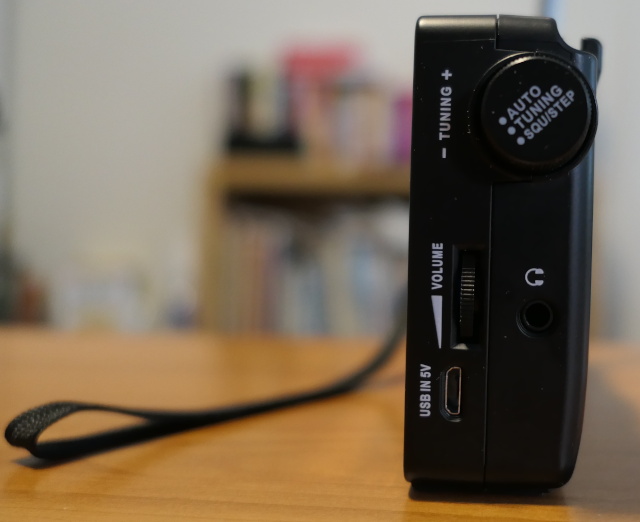
Tuning and storing stations in memory
The right side of the Qodosen (see left) contains a volume control, a headphone jack that will work with both standard audio and with cellphone-style plugs, and a micro USB charging port. One downside of this radio is that it doesn't use a USB-C port, which has become the modern standard, used by laptops, tablets, and cellphones. Even Apple has gone to USB-C. You can't plug in a USB-C connector the wrong way while it feels like you always try to plug in a micro-USB connector wrong the first time.
Headphones, earbuds, or the like are required for FM stereo reception. FM reception will always be in mono when the built-in speaker is used. The speaker has reasonably good sound for its size. It won't boom, but it doesn't sound tinny or shrill, either.
The tuning knob is one of multiple ways to tune stations on the DX-286. The knob can tune at either "fast" or "slow" speeds. For example, "fast" FM tuning can be in 100 or 200 kHz steps while "slow" tuning is in 10 kHz steps. I've found that "fast" tuning is best for most purposes. There's also an "auto" mode which, allows you to turn the knob just once in order to tune to the next station. Essentially, it's a function to seek the next station. This is most useful in areas where there are fewer FM stations. You can switch between the modes by pressing in on the tuning knob.
You can also enter the frequency of the desired station directly when the station is in frequency-tuning mode. The DX-286 takes the best approach I've seen so far to frequency entry. Just press the numbers of the frequency you want, followed by either AM or FM, depending on the band you want. This also lets you skip to the desired band without taking an extra step to switch bands. But if you just want to switch bands, press either AM or FM without first entering the frequency. This will take you to either the last AM or last FM station you had tuned to before switching bands.
Finally, when the station is in frequency-tuning mode, you can use the "up" and "down" buttons near the right edge of the front of the radio to tune up and down. This doesn't work in memory-tuning mode.
To switch between frequency-tuning and memory-tuning modes, quickly press the PAGE button. Then the numeric keypad and the up and down arrow buttons work together. The up and down buttons select the memory "page" (each page has 10 memory positions) while the numeric buttons select the memory position within the page. For example, if you have 97.3 MHz stored on page 4 at memory position 3, first press the "up" or "down" buttons until the display shows "PAGE-04", then press the "3" on the numeric keypad.
When in memory-tuning mode, the tuning knob tunes memory positions instead of frequencies. A nice feature is that you don't have to enter the page number first; for example, the knob lets you tune from page 3, memory 9 to page 4, memory 0 without any additional action.
Note that, in memory-tuning mode, the RDS/RDBS display is superseded by the display of the page number that's currently active.
You can store stations in memory positions manually by using the M/TONE button; just press M/TONE when tuned to the station you want to store. Use the DEL button to delete a station stored in memory. There are other methods of storing stations, too, described on pages 14 through 17 of the user's manual. To clear out memory totally, hold the DEL button until "DEL ALL" appears in the display. This will take about 10 seconds.
You can also store stations automatically by scanning. During a scan, you can either overwrite existing memory storage, or skip past previously stored stations it, storing new stations at new memory locations. The first mode is referred to as ATS cover and the second is ATS jump. You switch between them by pressing the "up" AUTO button while the radio is off.
The radio allocates memory pages 0 to 24 for FM stations, 25 to 29 for longwave stations (nonexistent outside Europe and northern Africa), and 30 to 44 for AM (mediumwave) stations. There are 10 memory positions in each page.
You can also scan for stations without storing them. This is done with long presses on the "up" and "down" buttons in frequency-tuning mode. You can also set the scan to stop at the next station, or to pause before continuing to find more stations. Page 8 of the user's manual has more details.
After all that detail, a reminder is useful: press the PAGE button to switch between tuning modes. Though I've used the memory-tuning modes, I prefer using the frequency-tuning mode.
Setting the clock and alarm
Setting the clock gets complex if you want to have the radio display both local time and so-called world time, in other words, Universal Coordinated Time (UTC). Rather than take up more space in this review on the subject, I've written a separate page explaining how to set the clock and the time zone.
If you just want to set the clock display to local time only, that's easy enough. With the radio off, long-press on the PAGE button. "CLOCKSET" should appear in the display. Turn the tuning knob to set the hour, then short-press on PAGE. Turn the tuning knob to set the minute, the short-press on PAGE. Then the display will flash either "RDS AUTO" or "MANUAL". Select one of those two settings with the tuning knob and press PAGE.
I strongly recommend using the MANUAL setting. The RDS AUTO setting uses data provided by radio stations to set the time. I've found that many stations report the incorrect time and the wrong time zone. This will make the clock report the wrong time, too. This isn't the radio's fault; it's the fault of radio stations that aren't managing their data stream properly.
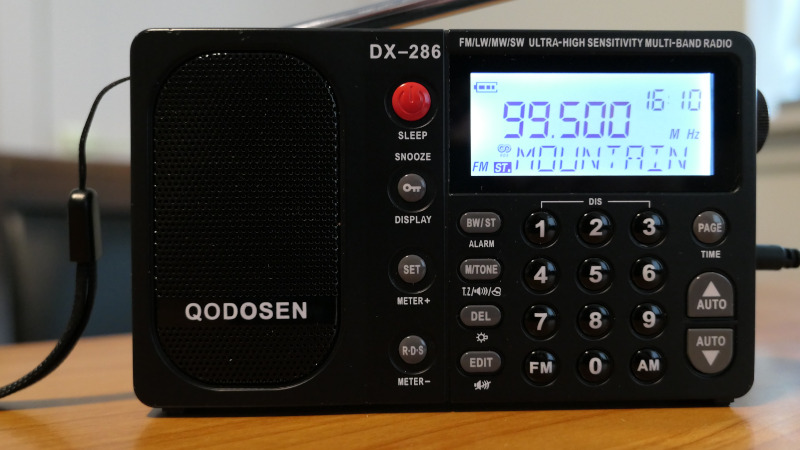
Options while listening
The DX-286 offers a wealth of options for use while listening. On FM, there's something called "signal processing", selected by long-pressing on the SET button. There's a "default" position, and then three "FMMI" positions. The SET button toggles among them. Aside from bumped-up high-frequency response for "FMMI-2", I can't tell much of a difference among the other three processing positions.
I mentioned this in the Qodosen DX-286/SR-286 Facebook group, and Qodosen responded:
Basic principle of FMMI: – Conventional High Cut reduces the audio bandwidth based on signal quality detection without knowledge about signal content over the audio frequency band – FMMI divides the audio signal in a number of frequency bands and calculates for each frequency band the gain, making use of the desired signal content in each frequency band. The output of the different frequency bands are added resulting in the de-noised audio signal. We set several modes “DEFAULT” / “FMMI→X” (X=1~3) for the FMMI algorithm to facilitate the user's choice, and different modes will have different sounds. The user can choose which mode he likes to use. Each person may have a different sense of sound, and “DEFAULT” mode is considered to be a more balanced mode. If you like FMDX, I suggest you choose FMMI-1 mode, which can restore the weak signal to the maximum extent, and this mode will not cause the weak signal to be blocked and intermittent phenomenon.
Qodosen further explained, "The FMMI selection of the DX-286 is an advanced feature of the TEF6686. FMMI function is more advanced than Highcut and Lowcut (filters), FMMI this way can replace or strenghten the standard highcut weak signal handling. FMMI is a multiple band dynamic noise reduction system for improved sound quality during poor signal reception conditions."
So it appears the differences among the four modes are subtle, and designed to be that way. Because I'm at an age where there's some high-frequency hearing loss, I also may be unable to hear some of these effects. In any event, I usually use the "default" setting, and it seems to be just fine.
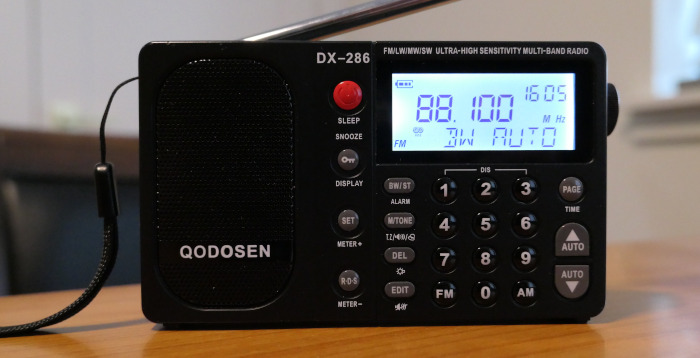
Also on FM, the Qodosen offers 16 choices for FM bandwidth, plus an automatic setting. I've found that the automatic setting (pictured) works perfectly in almost all situations. Short-press the BW/ST button while listening to the FM band to select the bandwidth, or to select the automatic setting. Note that setting the bandwidth to be very narrow causes noticeable distortion and may also prevent RDS/RDBS data functions from working. I've found that 114 kHz is the minimum acceptable bandwidth setting for using the radio. On the other hand, setting the bandwidth really wide, more than 200 kHz, may make the radio less selective in situations where the FM dial is jam-packed. I face such a situation in Denver, where a translator on 93.7 is next to a low-power FM on 93.9 that's next to another translator on 94.1, and where a station in Colorado Springs at 94.3 often makes its way in. Any bandwidth setting greater than 200 kHz causes these stations to interfere with one another. The FCC lowered its standards to accommodate activists wanting low-power FM stations, and this chaos was the result.
On AM, the Qodosen offers four bandwidth choices. They're also selected with the BW/ST button, this time while listening to the AM band. The choices are 3 kHz, 4 kHz, 6 kHz, 8 kHz. Some DXers have complained that there isn't a narrower bandwidth available. I don't have a problem with this, since I have trouble hearing anything intelligible with a bandwidth less than 2.5 kHz anyway.
The default AM bandwidth is 4 kHz. The radio will reset itself to that default whenever it's turned on. After getting questions on Facebook from DX-286 owners about this behavior, Qodosen confirmed that this is normal for the DX-286. Qodosen's first model, the SR-286, did not reset the bandwidth every time the radio is turned on. Qodosen's explanation was that "some [SR-286] users don't know how to adjust the bandwidth according to the actual reception situation, which leads them to think that the radio was malfunctioning" when it really wasn't. So Qodosen implemented the 4 kHz default setting as a reasonable trade-off between selectivity and audio quality, which can then be adjusted by the user as desired.
I believe that the description of at least two of the four bandwidth choices isn't accurate, with the 6 and 8 kHz bandwidth settings actually having a narrower bandwidth than indicated. More details are in this in-depth examination of the AM bandwidth filters.
On all bands, there's also a tone control. You long-press the M/TONE button to toggle between them. The "music" mode has a relatively flat frequency response; the "voice" mode reduces high frequencies along a gentle curve starting at 2.5 kHz:
- -4 dB at 5 kHz
- -6 dB at 7 kHz
- -10 dB at 10 kHz
The effect is much more subtle than "voice/music" switches on other DSP-based radios. On the Qodosen, it might actually be more useful on FM than AM. In my experience, the tone control has less effect on the sound quality of an AM signal than the bandwidth setting.
The sound quality, by the way, is excellent when using headphones and reasonably good when using the speaker. An obscure Qodosen website that I found during a search may indicate why the sound quality is good, especially with headphones.
The DX286 uses separate amplifiers for speakers and headphones to reduce interference and enhance sound quality, with greater dynamics, wider range and less distortion.
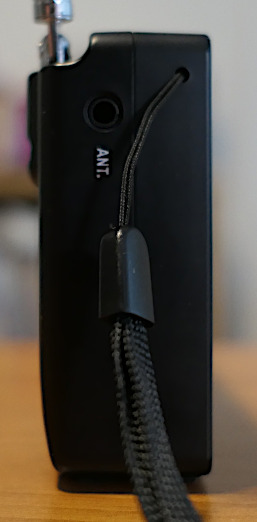
One feature of this radio that has attracted a lot of attention is its ability to switch between an internal and an external antenna for AM reception. There is an external antenna jack on the left side of the radio (as shown at the left; right-click on the image and select the option to open the image in a new tab or window for a larger view). Reports vary on whether this jack also supports an external FM antenna. I have found no difference, but I've just tested this with a single 30-inch wire on FM. While the radio's whip antenna is more than 10 inches too short for optimal FM reception, I've also found that using an FM antenna extender, in this case a Tecsun AN-07, makes only a minor improvement. Other experimenters have reported improvements when using antenna extenders, so possibly any improvement will depend on your locations and the signals available there.
The whip antenna can be used for AM reception as well when nothing is plugged into the antenna jack, but it's nondirectional and more prone to picking up electrical interference than the built-in ferrite loop. To switch between the internal ferrite antenna and the antenna jack, long-press the RDS button.
There's also an antenna amplifier for use with the antenna jack. Long-pressing the SET button turns it on and off. In areas with electrical interference, which, unfortunately, tends to be most urban areas, the amplifier may simply allow that interference to drown out signals. It's best to experiment to see what happens at your location.
A good external antenna that's readily available is the Terk Advantage, available through C. Crane or Amazon. It's tunable and directional. It's billed as an indoor antenna, but it can be used outdoors. In fact, that's where I've gotten the best results. It can plug directly into the DX-286's antenna jack with a patch cord that has 3.5mm mono plugs at each end.
Back to FM: you can also force all reception to be in mono even when using headphones. Long-press the BW/ST button to toggle between stereo reception or full-time mono reception. This only has an effect when headphones are plugged in.
Other settings
Some settings can be changed only when the radio is off. Most are accessed by long-pressing the SET button when the radio is off and then turning the tuning knob until the desired setting appears and then short-pressing SET to find the desired value for that setting. These include:
- Setting the AM tuning step to either 10 kHz (Western Hemisphere) or 9 kHz.
- Setting the FM tuning range. In North America, use 87.5-108 MHz. For Europe, 87.0-108 MHz may be more appropriate. In Japan, use 76-108 MHz to cover the Japanese FM band between 76 and 90 MHz.
- Setting the FM tuning step. I use 100 kHz; in North America, 200 kHz is also sufficient. Other, smaller steps are available as well.
- Setting the FM de-emphasis to either 75 µsec (North America) or 50 µsec (elsewhere).
- Setting radio data to RDBS (North America) or RDS (mainly Europe).
- Turning longwave reception on or off.
Time and the alarm are set with the radio off as well. Pressing RDS when the radio is off toggles between having a beep every time a button is pressed and turning that beep off.
The bottom line of the display will indicate which setting can be changed.
Performance
Not only did I want to compare the DX-286 to what I believe is its closest competitor, the Tecsun PL-320, I also wanted to compare it to an earlier generation of DSP-based radios. Since I had moved from the San Francisco Bay Area to Denver, I was starting with the proverbial blank sheet of paper.
I go into some detail about these comparisons in a separate in-depth page. In particular, I developed a scoring method that is a little more complex than the simple station count that I used in the Bay Area. For this review, I'll just summarize the results.
On AM, the DX-286 was outperformed by the Tecsun PL-320 and the Digitech AR-1780 (which is nearly identical to the XHDATA D-808). I'm sure the AR-1780 performed better simply because it was a larger radio with a bigger internal ferrite antenna compared to the DX-286. That's no surprise, and something that the DX-286 can compensate for with an external antenna, which is something it supports very well. The comparisons I made were "barefoot", with each radio's built-in antenna. Comparisons with external antennas could have had different results.
The PL-320's performance, though, was nearly equal to that of the Digitech AR-1780. One thing I noted about the PL-320 was its very aggressive automatic gain control (AGC). This may have helped it suck weak stations out of the noise more effectively than other radios.
In a second, later evaluation, the Qodosen DX-286 and the Tecsun PL-320 were again nearly equal in their AM performance. So I believe the results of the first evaluation weren't a fluke.
All that said, the Qodosen DX-286 still was a better performer than the earlier generation of DSP radios, such as the Tecsun PL-310ET, Tecsun PL-380, C. Crane Skywave, and the Grundig G8 (manufactured by Tecsun). You can tell that the state of the art in radio receivers continues to advance. Moreover, the results were all very close. All these radios are very good.
One thing to note is that, from time to time, the display may cause a slight ticking noise to be heard in the audio. This only happens when the internal antenna is used. You can avoid this noise by turning the display off. Press the 1 and the 3 buttons together to turn the display off. Pressing any other button or turning the tuning knob will turn the display on again. Otherwise, the radio is free from internally generated noises, a big improvement over earlier generations of DSP-based radios.
In a separate session, I compared the DX-286 and two other DSP-based radios, the Digitech AR-1780 and the Tecsun PL-320, with the classic Sony SRF-A100 AM stereo radio. That Sony model was one of the best AM radios of the 1980s. Using the SRF-A100's narrow bandwidth setting, I found that its sensitivity and selectivity were almost as good as the Digitech and Tecsun radios, and slightly better than the DX-286. In wideband mode, the SRF-A100's sensitivity and selectivity were reduced, but the payoff is the frequency response and audio fidelity that's better than any DSP radio I've heard to this point.
The SRF-A100 likely benefited in this comparison due to its size, which, just as with the Digitech AR-1780, allows a larger internal AM antenna to be used. Up to a point, the larger the antenna, the better the AM performance will be. I did not use an external antenna with any of the radios in my comparisons.
I was not able to test longwave reception on the DX-286, due to the absence of such broadcast stations in North America.
On FM, the DX-286 was the best FM performer, with the Tecsun PL-320 being the runner-up. They were both just a little bit better than the other three DSP-based radios I compared them to, the Digitech AR-1780 and the Tecsun PL-310ET and PL-380. I used to consider the PL-380 to be my best FM radio, but the Qodosen now can claim that title. Again, I'll point out that all five of these radios are very good; the Qodosen is just a little bit better than the others. The differences aren't huge, and results could have been different on another day, since reception can vary from day to day.
As with the AM comparison, I performed a second comparison of FM reception a few months later. This time, the Qodosen notched a notably higher score than its nearest rival, the Tecsun PL-320. The PL-320 remained in second place. There can be variations in reception from day to day, but the rankings remained consistent. There can be no doubt that the DX-286 is a great performer for FM reception.
From my daily use of the radio, there's one odd note. While on most stations, the Qodosen could trigger stereo reception even at low signal strengths, there was one station for which that wasn't the case. KJAC (105.5) in the northern Front Range, though technically a fringe signal to my part of Denver, puts in a fairly good signal here, good enough for listenable stereo on any good receiver. (With the prospect of an unneeded low-power FM going on the air in nearby Aurora in 2025, that may change. The FCC lowered its standards to make LPFM advocates happy; one negative effect is that stations that once could be received consistently may no longer be available.) However, KJAC does not trigger stereo reception on my DX-286 even though weaker stations do. Perhaps there is something about KJAC that is causing this effect, possibly multipath, which is mild, but present during some of KJAC's spoken-word programming.
I'll admit that, for most stations, I wouldn't care about this. But KJAC happens to be one of my favorite stations, a noncommercial adult alternative station based at KUNC in Greeley, Colorado. So this quirk of reception has been a bit of a downer. I haven't encountered this problem with any other station, not just in Colorado, but also when I've brought along the DX-286 radio on my travels.
For FM, I'll also note that none of the radios tested had an antenna that was the proper 30-inch length for FM. I didn't use an antenna extender for any of the radios. Considering how well the Qodosen performed, even with an antenna that was not the correct length, I have to believe that it would have done even better with a properly-sized antenna.
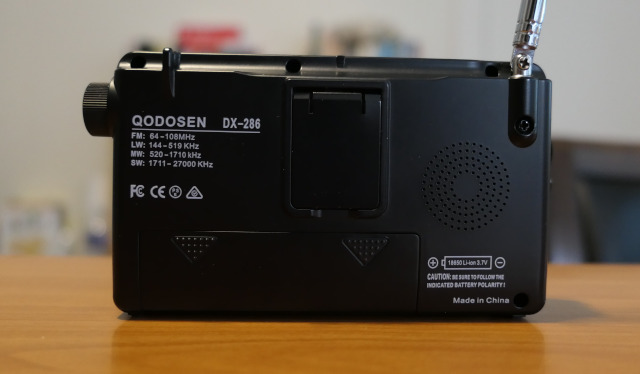
Conclusion
While there's no perfect radio, the Qodosen DX-286 comes close in many aspects. Just as with anything else, it could be improved. Most important, it should have an antenna that's the correct length for FM reception. For some reason, the Chinese radio manufacturers don't do this. With a telescoping antenna, a proper length for FM should be possible, but isn't. Instead, you have to use an antenna extender to get the correct length (about 30 inches) to optimize FM reception.
Using a USB-C port for charging would have been better than micro USB. Micro USB ports are likely to become obsolete in the next few years. USB-C is now being used by cellphones, laptops, tablets, etc. It also is easier to use: it works no matter which direction you plug it in with.
The kickstand on the back of the unit reportedly is somewhat fragile. It should either be strengthened or replaced by some other kind of support.
I'd also rather have standard AA batteries rather than a lithium-ion battery, but the TEF6686 chip may have power requirements that mandate the use of such a battery. Short battery life has been a complaint among some users, but the quality of 18650 batteries varies greatly, and they do not all have the same capacity. It appears that a 3000 mAh-capacity battery is best for the DX-286. I bought my Panasonic battery through Battery Junction, and have been satisfied with the result. It does take several hours for the radio to charge a battery , so having a second battery available to swap into the radio could be a good idea. Otherwise, an external charger could be used.
While the controls have improved from the original SR-286, the labeling could be more logical. The clock is somewhat difficult to set up properly. The user's manual has improved but sometimes can still be confusing to follow. On the other hand, the buttons used for input are generously sized, unlike some other DSP-based radios. The ergonomics of using the buttons and the tuning knob are good.
In any event, the performance of the DX-286 is outstanding. The sound quality is very good when using headphones. The speaker is better than average, too, but I prefer headphones or even earbuds. Once you learn the controls, the radio is enjoyable to use and the reception performance is among the best. I think it's especially a joy for FM listeners to use.
More on the Qodosen DX-286
» The official concise reference for the DX-286's functions and controls
» Comparing performance of the DX-286 with similar radios
» Detailed examination of the DX-286's AM bandwidth filters